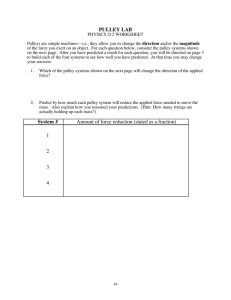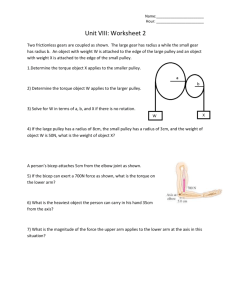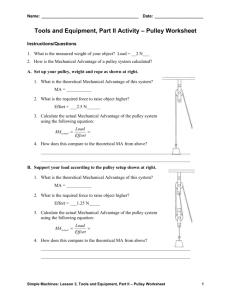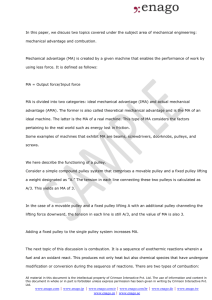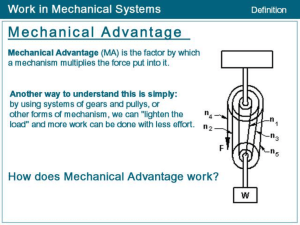Pulleys
advertisement
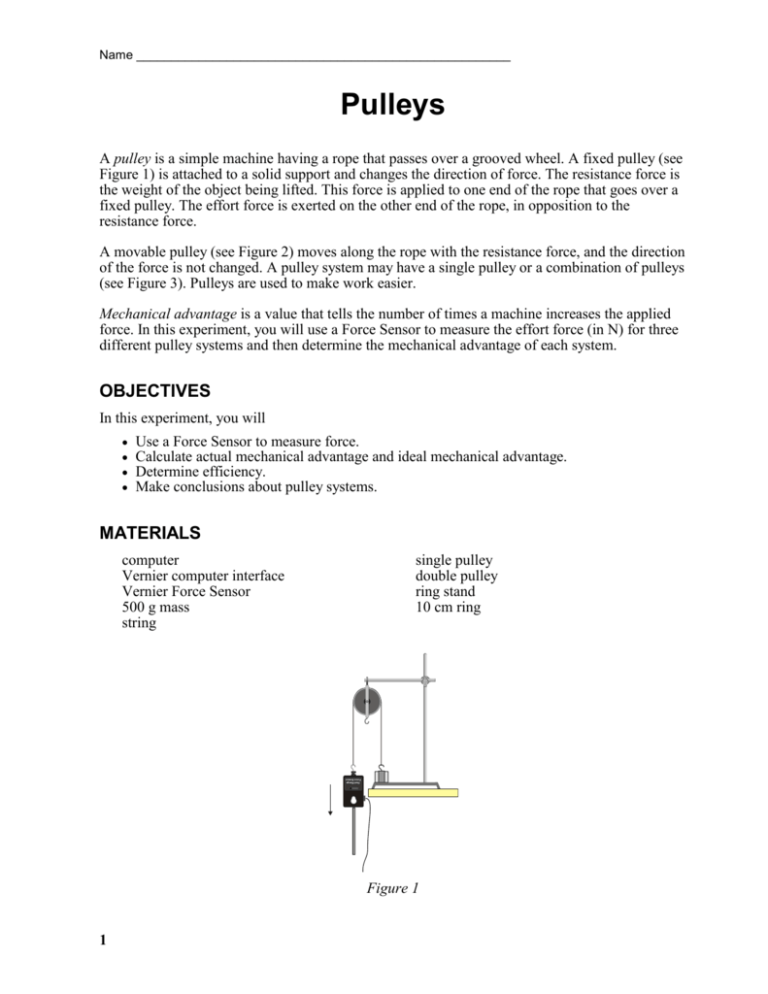
Name ______________________________________________________ Pulleys A pulley is a simple machine having a rope that passes over a grooved wheel. A fixed pulley (see Figure 1) is attached to a solid support and changes the direction of force. The resistance force is the weight of the object being lifted. This force is applied to one end of the rope that goes over a fixed pulley. The effort force is exerted on the other end of the rope, in opposition to the resistance force. A movable pulley (see Figure 2) moves along the rope with the resistance force, and the direction of the force is not changed. A pulley system may have a single pulley or a combination of pulleys (see Figure 3). Pulleys are used to make work easier. Mechanical advantage is a value that tells the number of times a machine increases the applied force. In this experiment, you will use a Force Sensor to measure the effort force (in N) for three different pulley systems and then determine the mechanical advantage of each system. OBJECTIVES In this experiment, you will Use a Force Sensor to measure force. Calculate actual mechanical advantage and ideal mechanical advantage. Determine efficiency. Make conclusions about pulley systems. MATERIALS computer Vernier computer interface Vernier Force Sensor 500 g mass string single pulley double pulley ring stand 10 cm ring Dual-Range Force Sensor Figure 1 1 Dual-Range Force Sensor Figure 2 Figure 3 PROCEDURE Pulley System 1 1. Zero the Force Sensor with its hook pointing down. a. Hold the Force Sensor in a vertical position with its hook pointing down. Make sure the hook is not touching anything. b. Click to zero the sensor. 2. Hang the mass to be used as the resistance from the Force Sensor. After the readings have stabilized, read the force (in N). This is the resistance force (Fr) for all three pulley systems to be studied. Record this value in all three resistance-force blanks in the data table. 3. Zero the Force Sensor with its hook pointing up. a. Hold the Force Sensor in a vertical position with its hook pointing up. Rest the tip of its handle on the tabletop. b. Click to zero the sensor. 4. Set up Pulley System 1. Attach a single pulley to a ring on a ring stand as shown in Figure 1. 5. Attach the Force Sensor to one end of the string and the resistance to the other end. Rest the resistance on the tabletop. 6. Raise the resistance 5 cm from the tabletop by pulling with the Force Sensor in the direction indicated in the figure (straight down for Pulley System 1). Read and record the effort force. 2 Name ______________________________________________ Pulley System 2 7. Zero the Force Sensor with its hook pointing down. a. Hold the Force Sensor in a vertical position with its hook pointing down. Make sure the hook is not touching anything. b. Click to zero the sensor. 8. Set up Pulley System 2 as shown in Figure 2. Repeat Step 6. Pulley System 3 9. Zero the Force Sensor with its hook pointing up. a. Hold the Force Sensor in a vertical position with its hook pointing up. Rest the tip of its handle on the tabletop. b. Click to zero the sensor. 10. Set up Pulley System 3 as shown in Figure 3. Repeat Step 6. 11. Look at Figures 1-3 and count the supporting ropes for each pulley system. All ropes are considered to be supporting except a rope that you pull downward (with the Force Sensor). A rope that you pull upward counts as a supporting rope. Record these numbers. DATA Pulley system Resistance force (N) Effort force (N) Supporting ropes 1 2 3 PROCESSING THE DATA 1. Calculate the actual mechanical advantage for each pulley system using the formula AMA = Fr / Fe where AMA = actual mechanical advantage, Fr = resistance force, and Fe = effort force. Show your work below. Record results in the table that follows Question 3. 2. The ideal mechanical advantage of a pulley is equal to the number of supporting ropes. See the supporting rope numbers in your data table and record the IMA values in the table following Question 3. 3 3. Calculate the efficiency of each pulley system in the space below and record the results in the table. AMA efficiency = IMA Pulley system AMA X 100% IMA Efficiency 1 2 3 4. How did the mechanical advantage of the single-movable pulley (Pulley System 2) compare to the mechanical advantage of the single-fixed pulley (Pulley System 1)? 5. How did increasing the number of pulleys affect the effort needed to raise the resistance? 6. Diagram a pulley system (different from the ones used in this experiment) that has a mechanical advantage of 2. 4

